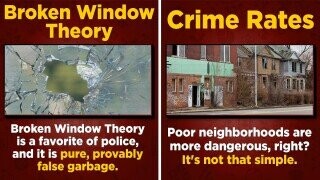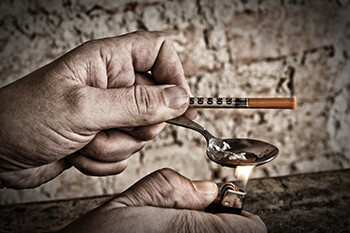4 Lies That Need To Stop Being Spread About 'Bad Neighborhoods'

Most people believe that some neighborhoods are good and some are bad, based entirely on crime statistics. At first glance, this methodology doesn't seem so bad, right? Some neighborhoods will naturally have higher crime rates than others, and some places will just be dangerous, right? And even if a neighborhood is dangerous, that can all be explained through socioeconomic issues, right? Well, not exactly.
See, everyone has been misled on this topic, like opening up a Playstation shaped Christmas gift, only to find a pair of unwanted socks. "Dangerous" neighborhoods are actually safer than you think, as crime statistics don't really tell the bigger picture, and that leads to some pretty bad myths, like ...
"They're more dangerous"
So there's this common misconception that "bad" neighborhoods are significantly more dangerous than other neighborhoods. After all, statistics don't lie, right? If a neighborhood has higher crime rates, you will be more at risk of a violent crime. Except, no, this is a colossal lie.
Don't Miss
Crime is pretty much concentrated in specific local places that don't affect the vast majority of people living there, along with basically being tied to specific social networks, like familial or organized crime. This means that your Supreme hoodie-wearing ass will not get robbed instantly when stepping foot inside a "dangerous" neighborhood" The average person in any presumed bad neighborhood is overwhelmingly not likely to be a criminal.
In 2015, researchers analyzed crime rates in Fox News' Black-on-Black crime scapegoat Chicago to determine how often violent crime occurs to random victims. Turns out, the results were entirely different from what the average person would expect. Crime in general in the windy city only made up about 6% of the entire population, disproportionately representing 70% of violent crime happening. This means that most of the violent crime is only occurring between an extremely small minority of people at any given time. Somebody tell Tucker Carlson.

And that's not all either. Another set of researchers from John Jay College conducted a wide survey of over 20 cities, revealing yet another fact that'd make conservative pundits lose their minds: in most major cities, crime is generally only done by an extreme minority of street gangs and groups that commit over 50% of the violent crime. This flies directly in the face of the often touted and subtly racist statement that some neighborhoods are just dangerous and need to be avoided.
But, you might say, some neighborhoods are just exceptionally dangerous, right? Like statistics don't lie, right? Except, well, no, as even in the most extreme cases where areas have sky-high crime like East Baltimore, violent crime is still extremely condensed to just a small percentage of the total population. It's almost like the racists who spew "data doesn't lie" crap don't actually check the data themselves. Who knew.
"They need more policing"
Overpolicing is often seen as a good thing, but the reality is quite different. The assumption that high crime neighborhoods simply just need a few more good cops is not only implicitly wrong, it's also quite dangerous, which is just about the trend for cops nowadays, surprise. Over-policing tends to create immense distrust among the people living in any given neighborhood, making a significantly worse relationship between the community and law enforcement to begin with. This doesn't bode well for inter-community relations either, given that this type of over-policing often leads to violence perpetrated by law enforcement on disadvantaged people.

CLP Media/Shutterstock
Numerous policing initiatives have come and gone over the years, one failing right after the other, like the infamous stop-and-frisk program implemented by then New York mayor Michael Bloomberg in 2003 that gave cops the power to search random "suspicious" people on the assumption that they might carry drugs or guns. As you could probably tell, most of these initiatives were steeped in racism, as critics often attacked programs like stop-and-frisk as unfairly punishing non-white people.
But surely, some of these programs had to be good, right? Not exactly. The controversial stop-and-frisk program actually did not result in much, if any, crime reduction. When the program expired, crime rates actually dropped, which sounds almost contradictory if you don't consider the fact that crime naturally decreases over time. Second off, a fair amount of arrests made by cops don't actually reduce crime that much or are actually false arrests.
Driven by the FBI's lack of transparency and accessibility on crime data, the Vera Institute of Justice analyzed crime and arrest trends across the nation for two years to understand the relation between arrests and crime rates. Their results run counter to the common assumption that more arrests reduce crime, as out of the 10.5 million arrests made annually, the vast majority are actually non-criminal in nature. A good chunk of arrests are also made solely for drug possession and other non-violent crimes at a strikingly disproportionate rate, with Black people being arrested for drug possession two-to-three times more than white people.
Even something as seemingly innocuous as fines issued out by police isn't exactly indicative of more stringent police work being a net positive for any area. The idea that more arrests/fines means that policing is working is pretty much a big lie, which would probably be very beneficial to the same people killing unarmed Black folks on the reg.
"It's mostly non-white/impoverished neighborhoods"
If there's one thing bigots love doing, it's blaming POC for just about every problem under the sun. Whether it be overpopulation or crime rates, a non-white person will get fingers pointed at them. This also applies to the argument that 'bad' neighborhoods are always non-white, which is patently false.
For starters, crime tends to be divided racially, with white people being overrepresented in some crimes than POC are, like drug dealing. Turns out that for the longest time, people just assumed that white people don't really deal drugs like POC do -- for mysterious non-racist reasons, of course -- and that drug dealing is mostly just self-contained in impoverished non-white neighborhoods. However, data shows that white people are actually about 45 percent more likely than Black people to sell drugs and are just as likely to use them.

Vidguten/Shutterstock
What explains this discrepancy? Well, like all things in life, those pesky white people just have it easier. Surprise. Turns out that white neighborhoods are actually safer for distributing drugs, as most drug transactions done by white people are usually done inside and among friends and family for a few socioeconomic reasons. In contrast, transactions done by Black people tend to be outside, which means that arrests are significantly more likely to occur.
This creates a huge gap in who is getting arrested, race-wise, with white people mostly winning like usual. And this is no more apparent than in the wild west of crime that is white-collar crime, which is often incredibly unreported, under-policed, and disproportionately white. Systemic racism creates the myth that only POC are perpetrators of crime, while crime committed by white people goes staggeringly unnoticed. But hey, that's what happens when entire groups of people are second-rate citizens based solely on skin color.
"Broken windows theory explains everything"
Developed in 1981 by sociologists George L. Kelling and James Q. Wilson, broken windows theory posits that the more run down and messy a neighborhood is, the more likely that crime will be cultivated. The basic idea is that nobody wants to ruin a nice place, whereas if a place is already pretty nasty looking, others will see no issue in making it even dirtier.
The theory has been a pretty convenient way for law enforcement and politicians to completely side-step all socioeconomic factors and nuances in favor of a neatly packaged one-size-fits-all explanation of why crime occurs. And this is all trash because it has very real-world consequences, like modern policing being directly informed by broken windows theory to a T.

Aleksandar Tasevski/Shutterstock
Why is this all a problem? Well, the issue here is that broken windows theory just completely and utterly fails to take into account how systemic racism operates entirely. Many impoverished neighborhoods suffer from racial segregation's continued legacy that left deep damage on Black neighborhoods for decades. Broken windows theory throws all of this away and attempts to place the blame and burden on individuals responsible for messing up their own community.
At worse, broken windows theory leads to even more aggressive forms of policing on innocuous crimes due to the idea that any crime, no matter how small, must be punished with maximum force. It's the kind of mindset that led to Eric Garner's death for selling cigarettes illegally, as cops think small crime begets large crime. But this has been proven false time and time again through sociological explanations for why crime actually does occur in some areas, like disproportionate poverty, racial discrimination, and over-policing. When it comes to race, however, white people aren't the biggest fans, obviously.
Top image: Alisafarov, Maroon Studio/Shutterstock